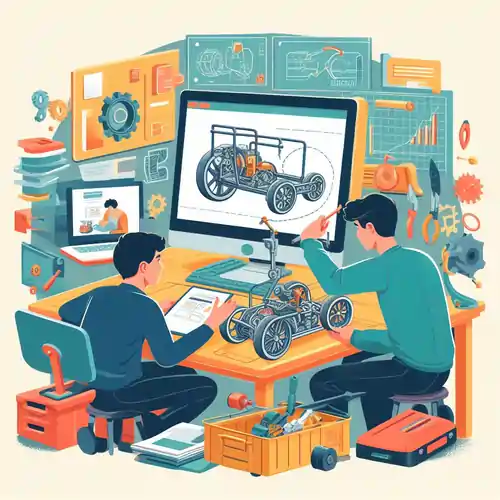Creating an Assembly Model of a Cart in CREO: A Comprehensive Guide for CAD Students

Computer-aided design (CAD) is a crucial skill in the modern engineering and design industry, and it plays an integral role in transforming ideas into tangible 3D models. CREO Parametric, developed by PTC, is a robust CAD software extensively used in both industry and academia. In this comprehensive guide, we will walk you through the process of creating an assembly model of a cart in CREO, offering valuable insights and tips to assist students in excelling in their CREO assignments, specifically providing assistance with CAD.
CREO Parametric supports parametric modeling, which allows changes made to one part of a model to automatically update other dependent parts. This feature enhances versatility, making it a preferred choice for tackling complex projects in CAD assignments. As students, mastering parametric modeling can significantly improve your efficiency and creativity.
CREO empowers you to create intricate assemblies, such as the cart we are about to build. The software provides a rich toolkit for assembling, simulating, and analyzing parts, ensuring that your designs are not only aesthetically pleasing but also fully functional. Proficiency in these assembly features will prove invaluable when dealing with assignments involving complex systems.

Proficiency in CREO Parametric is highly valued in the job market. Many engineering and design companies rely on CREO, so gaining expertise in this software can unlock lucrative career opportunities. As students, acquiring these skills can set you apart when seeking internships or entry-level positions in the field.
Now that we've established the importance of CREO Parametric, let's dive into the step-by-step process of creating an assembly model of a cart.
Preparing for the Cart Assembly
Before embarking on your design journey, it is absolutely critical to gain a comprehensive understanding of the cart's intricate structure and its myriad components. This imperative step necessitates the meticulous gathering of reference materials, including but not limited to sketches, detailed drawings, and exacting specifications. These reference materials will function as your guiding North Star throughout the entire modeling odyssey, serving as the bedrock upon which your design takes shape and ensuring that your creative vision harmoniously coalesces with the stringent demands and intricacies of the project's unique requirements.
This painstaking attention to detail at the outset will set the stage for a successful and proficient CAD endeavor, one that is not only educational but also a testament to your meticulousness and precision as a burgeoning CAD designer. With these reference materials in hand, you can dissect the cart's design, scrutinizing every angle, curve, and dimension. By doing so, you will uncover hidden nuances that may not be immediately apparent, allowing you to craft a CAD model that faithfully represents the cart in all its glory.
Plan Your Approach
A well-thought-out plan is absolutely indispensable for ensuring the success of any CAD project. Take ample time to meticulously outline your approach, taking into account critical factors such as the precise sequence in which you'll embark on creating different parts of the cart, your chosen assembly strategies, and meticulous attention to any specific constraints or unique design considerations that are inherent to the cart's design.
A systematic and thoughtful approach to your project not only functions as a time-saving measure but also serves as a potent tool for enhancing the overall quality of your work. The ability to methodically plan and execute CAD projects is an invaluable skill that will undoubtedly set you apart when facing intricate CAD assignments, where attention to detail and precision are paramount for achieving outstanding results.
Creating Individual Cart Parts
The wheels and axles constitute critical elements of the cart's functionality. Start by crafting a wheel and axle assembly, following these steps:
- Sketch the Wheel Profile: Commence by meticulously sketching the wheel's profile, making certain that you incorporate accurate dimensions and constraints. The significance of precision cannot be overstated in CAD assignments; hence, initiating your design with a meticulously defined sketch is not merely beneficial but imperative.
- Revolve the Profile: Employ the revolve feature with expertise to effectuate the transformation of your 2D wheel sketch into a highly detailed and realistic 3D representation. Proficiency in mastering this tool is not merely beneficial but indispensable, as it is a cornerstone feature in CREO Parametric, and pivotal for achieving accurate designs.
- Design Axle Components: Dedicate your attention to the intricate design of the axle and its associated components, with an unwavering commitment to achieving precise alignment with the wheel. A meticulous focus on detail in part design is not merely advantageous but a non-negotiable requirement, as it substantiates the realism and functionality of your assembly.
- Assemble Wheel and Axle: Employ assembly constraints with mastery to orchestrate the seamless assembly of the wheel and axle components, ensuring their synchronized rotation. Proficiency in the art of applying assembly constraints is the linchpin to successfully navigating CAD assignments characterized by the complexity of multiple interconnected parts. It is the key that unlocks the path to flawless assemblies that mirror real-world functionality, a skill of paramount importance in the realm of CAD.
Frame and Handle
Shift your focus to the cart's frame and handle, elements essential for the cart's structural stability and user-friendliness:
- Frame Skeleton: Initiate your frame design by creating a skeleton or framework for the cart. Begin with a basic outline sketch and subsequently extrude it to create the framework's structure. Mastering sketching and extrusion techniques is essential, as these are fundamental skills in CAD modeling.
- Handle Design: Craft a handle that securely attaches to the frame. Pay close attention to ergonomics and usability, ensuring that your design is not only aesthetically pleasing but also functional. The ability to design parts that blend form and function is a valuable asset in various CAD assignments.
- Assemble Frame and Handle: In the assembly workspace, bring the frame and handle together, ensuring their proper alignment and secure attachment. Proficiency in applying assembly constraints is vital to ensuring that your parts fit together seamlessly, a skill indispensable for CAD assignments featuring complex assemblies.
Assembling the Cart
CREO Parametric offers an extensive array of assembly constraints that intricately govern how individual parts interact and collaborate within an assembly. These constraints serve as the building blocks of assembling complex structures like the cart. The common assembly constraints you'll encounter include:
- Mate: This constraint facilitates the precise alignment of two surfaces or features within your assembly. Whether it's aligning a wheel with an axle or ensuring the handle's attachment to the frame, the "Mate" constraint plays a pivotal role in achieving accurate alignments.
- Flush: Ensuring that two surfaces remain parallel is crucial for the smooth operation of various assembly components. Utilizing the "Flush" constraint correctly guarantees that surfaces align seamlessly, eliminating potential misalignments that could hinder the cart's functionality.
- Insert: The "Insert" constraint is indispensable when components need to be inserted into one another, creating a secure and functional connection. Properly applied, this constraint ensures that components fit snugly and securely, preventing any unwanted play in the assembly.
- Distance: Precise measurements and spatial relationships are vital in CAD modeling, especially when specifying the distance between components. The "Distance" constraint allows you to maintain accurate spatial arrangements within the assembly, ensuring that critical design specifications are met.
Proficiency in applying these constraints is not only essential for assembling the cart with precision but also invaluable when tackling CAD assignments involving intricate assembly requirements. These constraints empower you to create realistic and functional designs that meet the highest standards of engineering and design excellence.
Explode and Collapse Views
To gain a comprehensive understanding of how your cart comes together, take full advantage of CREO's "explode" and "collapse" views. These invaluable features provide you with a detailed, step-by-step visualization of the assembly process, allowing you to scrutinize every component's placement and interaction. This granular view not only simplifies the detection of any potential interference or misalignment issues but also fosters a deeper appreciation for the intricacies of your design.
Proficiency in utilizing these visualization tools effectively extends beyond addressing immediate concerns; it equips you with the ability to communicate your design process concisely and convincingly. Such proficiency is a vital asset in the realm of CAD assignments, where clarity and precision are paramount for successful project execution.
Adding Realism and Functionality
Enhancing the realism of your cart is a crucial aspect of your CAD project. You can achieve this by meticulously assigning material properties to its various components. CREO Parametric, being a versatile CAD software, empowers you to specify materials ranging from common choices like plastic, metal, or rubber to specialized materials as per your design requirements. One of the notable advantages of using CREO is its ability to automatically calculate mass and other essential physical properties based on the chosen materials. This proficiency in material assignment and analysis becomes especially valuable when you encounter CAD assignments that demand a deep understanding of material selection, structural integrity, and performance characteristics. Having a solid grasp of these aspects allows you to create designs that not only look realistic but also function effectively and meet engineering specifications, a skill set that sets you apart in the world of CAD modeling and design.
Motion Analysis
Elevate your assembly to the next level by conducting thorough motion analysis. This indispensable feature empowers you to simulate every aspect of the cart's movement, meticulously ensuring that not only do the wheels rotate smoothly, but also that the handle's motion is ergonomically perfect. Developing proficiency in motion analysis tools is a significant advantage, especially when CAD assignments demand intricate dynamic simulations or in-depth kinematic analyses. These skills will not only enhance the realism of your designs but also provide the functional insights needed to excel in complex projects, pushing your CAD capabilities to new heights.
Conclusion
In conclusion, creating an assembly model of a cart in CREO Parametric presents an exceptional learning opportunity for CAD students, offering a gateway to honing vital skills that extend beyond the confines of the classroom. This practical exercise not only equips you with the core CAD competencies required for success but also provides a glimpse into the challenges and intricacies of real-world engineering and design projects, preparing you for a future career in the industry.
As you embark on this journey, remember the importance of meticulously gathering reference materials, as they serve as the foundation of your design. The act of planning your approach not only ensures efficiency but also cultivates problem-solving skills essential for tackling complex CAD assignments effectively. Additionally, paying meticulous attention to assembly constraints imparts a valuable understanding of precision and detail, a trait highly regarded in the world of CAD.
By faithfully following the comprehensive steps outlined in this guide, you will find yourself well-equipped to not only excel in your CAD assignments but also to elevate your CAD skills to unprecedented heights. So, with unwavering enthusiasm, ignite CREO Parametric, embark on your design odyssey, and immerse yourself in the enriching and rewarding world of CAD modeling. Your journey starts now, and the possibilities are boundless.